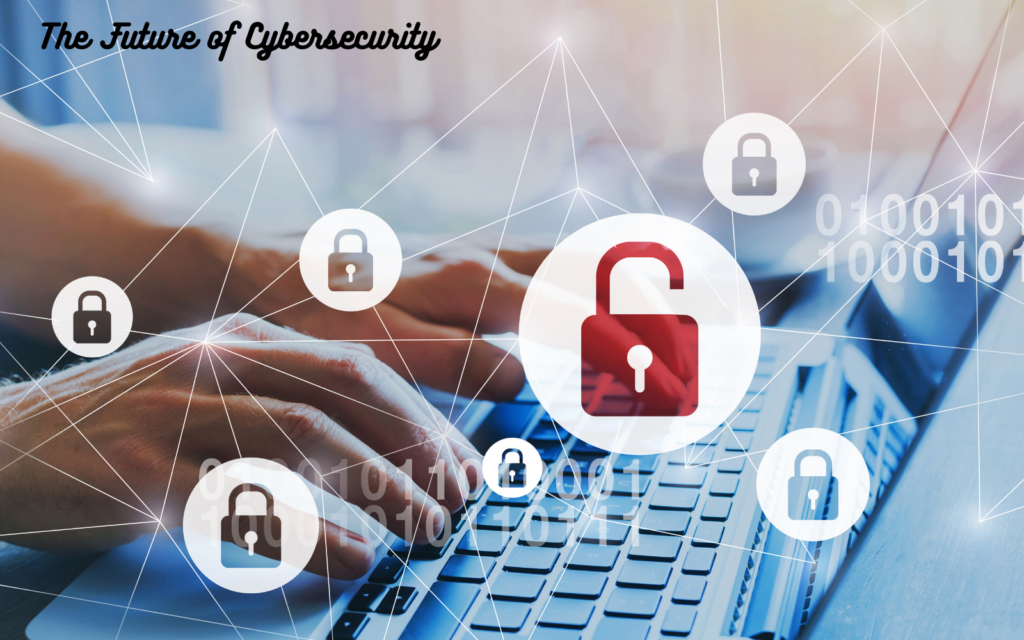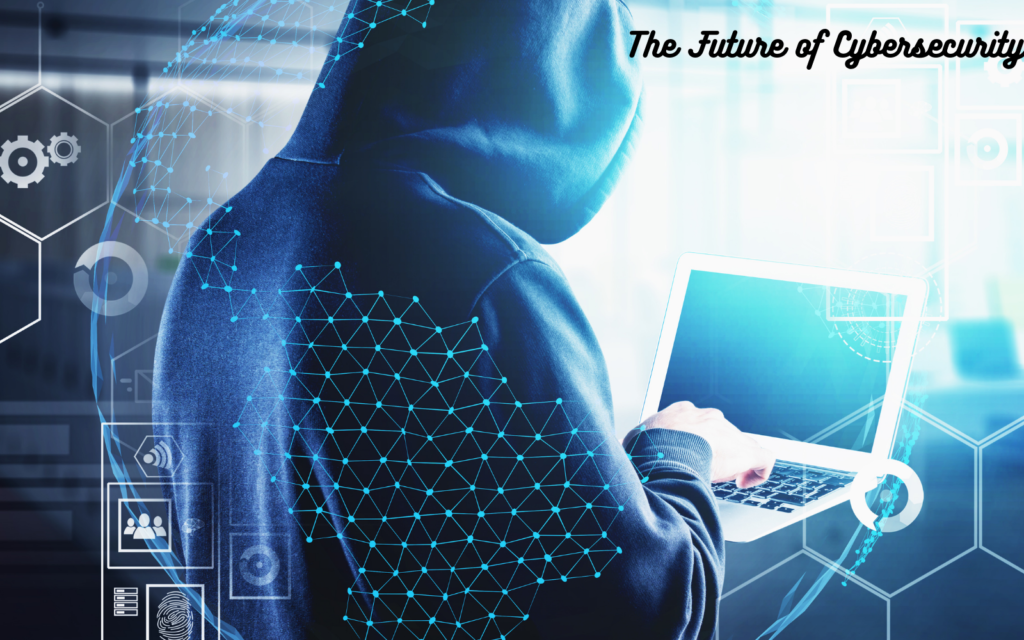Introduction: The Future of Cybersecurity: Predictions and Trends

“The Future of Cybersecurity: Predictions and Trends” is a fascinating look at future cybersecurity trends. The phrase “The Future of Cybersecurity” makes you wonder what’s next in digital security, which is continually changing. It requires proactive learning and response to new cyber threats and the creation of technology and tactics to strengthen security.
Table of Contents
Anticipated technological advancements in cybersecurity:
Cybersecurity is fascinating, and new technologies will transform digital asset protection.
These enhancements include:
Quantum Cryptography:
Quantum computers may break cryptography. Quantum cryptography is projected to advance greatly, making communication lines safe against quantum attacks.
Zero Trust Architecture:
Cybersecurity will increasingly use zero trust security approaches. This technique distrusts everyone inside and outside a network and carefully analyzes every user and device that accesses resources.
AI-Powered Threat Detection:
AI and machine learning algorithms may help identify and halt internet threats. AI-powered technologies can search massive data sets in real time for anomalies and security flaws.
Biometric Authentication:
People may employ biometrics and other stronger kinds of identification. Biometrics like iris, fingerprint, and face recognition are safer than passwords.
Secure Internet of Things (IoT):
As IoT devices proliferate, safety will be crucial. Future work may focus on robust security and encryption capabilities to protect IoT devices from cyberattacks.

Emerging trends in cyber threats and attacks:
It’s crucial to anticipate new online risks and attacks as we plan cybersecurity’s future.
Important considerations include:
Ransomware-as-a-Service (RaaS):
More platforms will likely let non-technical persons initiate ransomware attacks for a portion of the earnings. This idea may increase ransomware attacks and sophistication.
Artificial Intelligence-Powered Attacks:
Cybercriminals may employ AI to undertake more targeted and automated attacks. AI-based technologies may bypass security, create convincing scams, and launch large-scale attacks without human assistance.
Supply Chain Attacks:
Hackers may find weak points in the supply chain to break into a trusted vendor’s system and access several interconnected networks. Supply chain security must be improved to prevent these risks.
Attack Vectors in Cloud Security:
As more individuals use cloud services, cyberattacks against cloud settings may increase. Future cybersecurity initiatives must protect cloud systems, data, and apps from new attacks.
3D Printing Vulnerabilities:
As 3D printing technology advances, security vulnerabilities may arise. Hackers could use 3D printing faults to make items less exact or complete, endangering aerospace, healthcare, and manufacturing.
Evolving strategies for enhancing digital security:
Cyber risks are growing, thus new cybersecurity measures are being established to improve digital security. These techniques include crucial elements:
Zero Trust Framework:
As corporations abandon perimeter-based security, they may adopt Zero Trust principles. The Zero Trust technique checks people and devices regularly and enforces rigorous entry rules since there are risks inside and outside the network.
Continuous Security Monitoring:
Companies may utilize solutions for continuous security monitoring to detect and stop threats instantaneously. This strategy helps identify suspicious activity and security issues quickly, reducing cyberattack & Cyber crime detection and prevention time.
Dynamic Risk Assessment:
“The Future of Cybersecurity” plans may contain dynamic risk assessment models that adapt to threats and weaknesses. Checking risk variables and updating security policies helps prepare organizations for emerging cybersecurity threats.
Encryption and Data Protection:
As data breaches increase, encryption and data protection are becoming more vital in safety strategies. Data and “The Future of Cybersecurity” measures will include end-to-end encryption, data masking, and secure storage.
Human-Centric Security:
Because individuals make mistakes, “the future of cybersecurity” plans will focus on employee training, awareness, and behavioral analytics to limit human error. Companies must foster security knowledge and accountability to improve digital security.
Impact of artificial intelligence and machine learning on cybersecurity:
AI and ML may transform how organizations protect themselves from internet attacks in the future.
Important considerations in this case:
Advanced Threat Detection:
AI and ML algorithms will make threats easier and more accurate to find, improving safety. These tools can analyse massive volumes of data in real time to identify cyberattack trends. This helps companies prevent system failures.
Behavioral Analytics:
AI and ML will be important in defensive behavioral analytics. These technologies can identify unusual user behavior and network activities that may indicate security flaws or insider hazards for speedy remedy.
Automated Response:
AI-powered cybersecurity systems may automate incident response, reducing risks fast and precisely. Automation speeds response times, mitigates security problems, and boosts cybersecurity team productivity.
Adaptive Security Measures:
AI and ML can adapt security measures to new threat data. Cyberdefenses will be more flexible and rapid to adapt to new threats and system weaknesses, strengthening security.
Threat Prediction and Prevention:
AI and machine learning for predictive analytics can help organizations identify and prevent cyber threats. These systems can predict future attacks, allowing for preemptive hacking prevention.
Importance of proactive measures and predictive analysis:
“The Future of cybersecurity” will emphasize preemptive measures and predictive intelligence to keep ahead of new threats.
Important considerations are:
Threat Prevention vs. Reaction:
Hacking will increasingly focus on threat prevention rather than problem solving. Proactive security measures detect and repair vulnerabilities before bad actors do.
Predictive Analysis:
Defense programs will increasingly use predictive analytics. Data-driven insights and machine learning algorithms help organizations forecast threats, trends, and weaknesses. This lets them strengthen their defenses and prepare targeted security measures.
Risk Assessment and Mitigation:
Proactive cybersecurity initiatives include risk assessment and mitigation to identify and repair security vulnerabilities. Predictive analysis helps you identify dangers so you can prevent them.
Threat Intelligence Sharing:
“The Future of cybersecurity” initiatives will require commercial partners to collaborate. Businesses may strengthen their defenses against new threats by exchanging threat intelligence and best practices, making the cybersecurity system more resilient.
Security Automation:
Proactive steps will automate security procedures to improve threat detection, incident response, and operations. Automated systems can constantly analyze surroundings for unusual behavior, detecting and fixing security issues before they worsen.
Growing significance of data privacy and regulatory compliance:
Data protection and compliance are becoming increasingly vital when considering “The Future of cybersecurity”.
Important reminders:
Data Protection Regulations:
Hacking will increasingly require compliance with data protection laws like the GDPR and CCPA. Businesses must implement strong data privacy protections to secure private information and comply with evolving regulations.
Consumer Trust and Transparency:
Maintaining consumer trust and transparency regarding data handling will be crucial in the future of hacking. Customers will trust and stay with companies that prioritize data privacy and are transparent about how they collect, store, and process data.
Data Encryption and Pseudonymization:
Data encryption and pseudonymization will be needed in the future to protect data. Encrypting private data during transmission and storage shows organizations’ commitment to data privacy. This reduces data leaks and illegal access.
Incident Response and Data Breach Notification:
As cyber dangers develop, firms must have effective plans to address incidents and notify customers of data leaks. For trust and compliance, you must swiftly detect and respond to security issues and connect with data breach victims.
Third-Party Risk Management:
As firms increasingly engage third-party vendors and service providers, cybersecurity must address third-party risks. To protect the ecosystem, vendor risk assessment must be thorough and third parties must respect data privacy and security standards.
Collaboration and information sharing among cybersecurity professionals:
In “the future of cybersecurity”, experts must collaborate and exchange information to improve security.
Important considerations are:
Threat Intelligence Sharing:
“The future of Cybersecurity” under the Cybersecurity specialists will collaborate more to share threat intelligence and cyber threat information. Sharing tools and knowledge helps organizations enhance their security and remain current on hacking trends.
Industry Partnerships and Alliances:
Industry Partnerships and Alliances: Businesses, industry associations, and “The future of cybersecurity” providers will collaborate more. These ties can help cybersecurity experts from other industries share best practices, techniques, and other resources.
Public-Private Collaboration:
Governments, law enforcement, and private corporations will collaborate more to combat global cyber threats. Public-private agreements can enable people share threat information, get help following the rules, and collaborate on cybersecurity projects.
Cross-Sector Collaboration:
In “the future of cybersecurity”, cross-sector collaboration will be crucial because cyber threats can touch many professions. Collaboration between finance, healthcare, technology, and vital infrastructure can broaden cybersecurity research. They can discuss threat detection, incident response, and risk reduction.
Professional Development and Knowledge Sharing:
Cybersecurity professionals will collaborate on training, skill development, and knowledge exchange. Sharing knowledge and experiences helps cybersecurity professionals learn best practices and keep up with new tools and threats.
Development of cybersecurity skills and talent for the future landscape:

As cybersecurity evolves, it’s crucial to improve skills and abilities to handle emerging cyber threats.
Important future considerations:
Specialized Training Programs:
As cyber attackers become smarter, cybersecurity workers will need specific training to protect themselves. Future training may cover data analytics, disaster response, ethical hacking, and cloud security.
Continuous Learning and Up-skilling:
Future cybersecurity workers will be lifelong learners. Cybersecurity professionals must attend conferences, training programs, and certification programs to stay current on new technologies, tools, and methodologies.
Diverse Skill Sets:
Hackers will need more than technical talents in the future. Cybersecurity issues require risk management, compliance, communication, critical thinking, and problem-solving.
Enhanced Collaboration and Teamwork:
Cybersecurity workers will need to collaborate in the future. Working well with colleagues from diverse departments, explaining security concepts to non-experts, and sharing threat information with peers are key abilities.
Emphasis on Soft Skills:
In addition to technical talents, cybersecurity will require people with soft skills including emotional intelligence, adaptability, creativity, and resilience. These abilities are essential in high-stress, ever-changing cybersecurity environments.
By investing in cybersecurity training, companies can create a well-rounded staff able to handle future cyber threats.
Conclusion:
Cybersecurity will be fast-paced and demanding in the future. People must be proactive, collaborate, and learn new skills to avoid emerging cyber threats. Advanced technology like AI and ML, increased collaboration and information sharing among cybersecurity professionals, and the need to develop new cybersecurity skills and talent will influence “the future of cybersecurity”.
Forward-looking predictive analysis can help companies improve security by predicting threats and system flaws. Cybersecurity specialists can increase defenses, minimize risks, and establish powerful systems that can manage emerging cyber threats by prioritizing data privacy, following rules, and aggressive security.
“The future of cybersecurity” depends on industry, government, and cybersecurity experts sharing information, working together, and encouraging a culture of learning and innovation. Skill development, diverse recruiting, and a collaborative cybersecurity ecosystem can help organisations adapt to evolving threats and cyber dangers.
People also ask:
AI and machine learning will be crucial to cybersecurity threat identification and response. Quantum encryption may become standard to defend data against quantum attacks. Automation will help combat more sophisticated cyberthreats. Organizations and governments must collaborate and share information to fight cybercrime. Staying ahead in cybersecurity requires a holistic approach integrating technology, human expertise, and proactive measures.
Quantum computing, AI, and IoT gadgets will challenge cybersecurity in the coming decade. Effective risk mitigation requires stricter rules and improved defense measures. Innovation to battle evolving cyber threats and prevent data breaches requires corporate, government, and university collaboration. Building a trained workforce that can handle the future’s complicated cybersecurity scenario requires ongoing education and upskilling.
Pingback: Join the Fight Against Cybercrime: You Can Make a Difference